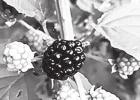My panic was palpable. After all, I was looking straight at Finn, my 2-year-old gigantic baby of a standard poodle. He’s been through so much. His idiopathic epileptic seizures started when he was only 6 months old. They grew longer and became more aggressive as the months ticked away. None of the preventative drugs seemed to work. Finally, our vet found a suitable cocktail: Phenobarbital and a double dose of Zonisamide. And, nearly two years later, here he was in the backyard, covered in blood? He’s not allowed in the backyard without me. Even though he’s been seizure free for nearly a year, we are told it isn’t a matter of if those seizures could break through but when they become too prevalent for the meds to block. Part of a successful seizure protocol is making sure the surroundings are safe. So, he goes outdoors with me. But, where is the blood from? Standard poodle brother Tucker is a lover, not a biter. Rescue dachshund senior brother Poe is, well, a low rider. He’s passive, too, but even so, the best he could catch would be an ankle. In fact, I can shamefully admit that Poe is usually the receiver of injustice when in the backyard. He always seems to be in too close proximity of the pood’s urine streams, constantly needing a sink bath after an afternoon outside. Finn seems ok. Yet, there’s the blood. It’s on his temple. It’s near his neck. It’s on his flank. Why, there’s even blood on his booty! I look at him. He looks at me, perplexed at the attention he’s receiving. He does that adorable head tilt to one side, as if to say, “Mom, I know I’m cute, but stop staring.” It hits me. This isn’t blood at all. Why, I should have noticed the tint was closer to a hot pink on the color wheel. I look up. I look around. Yep, it’s berry season. I feel intense relief followed by intense desperation. The mulberries are everywhere.











